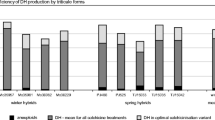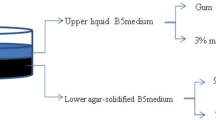Abstract
Efficient methods of chromosome doubling are critical for the production of microspore-derived, doubled-haploid (=DH) plants, especially if, as in maize anther culture, spontaneous chromosome doubling occurs infrequently. In the present study, colchicine (5–1000 mg/l) was added to the induction medium and maize anthers were incubated in the colchicine-containing medium for different durations (1–7 days). In order to improve overall anther culture response, the culture temperature was adjusted to 14°C during the first 7 days. Colchicine applied at low concentration, i.e. 5 mg/l (7 days), or for short duration, i.e. 1–3 days (250 mg/l), showed beneficial effects on the formation of embryolike structures (=ES) and thus led to increased plant production, but was comparatively ineffective regarding chromosome doubling. Optimal doubling effects were observed when anthers had been exposed to culture medium containing 250 and 1000 mg/l of colchicine (7 days); in these treatments the doubling index (=DI), defined as the quotient of the number of DH plants and the number of totally regenerated plants in a specific treatment, rose to 0.56 and 0.53, respectively, compared to 0.20 in the untreated control. However, colchicine administered at concentrations higher than 250 mg/l seemed to be detrimental to general plant production; thus, in spite of a high DI, the overall DH plant production was even lower than in the control treatment. Maximum DH plant production for three different genotypes was accomplished with culture medium containing 250 mg/l of colchicine (7 days). With the best-responding genotype (ETH-M 36) a DH plant production of 9.9 DH plants/100 anthers was accomplished, i.e. a 7-fold increase compared to the non-treated anthers. This is the first report on efficient chromosome doubling in anther culture by subjecting anthers to colchicinecontaining induction medium during a post-plating cold treatment. Chromosome doubling as described here becomes an integral part of the maize anther culture protocol and thus represents a rapid and economical way to produce DH plants.
Similar content being viewed by others
References
Alemanno L, Guiderdoni E (1994) Increased doubled haploid plant regeneration from rice (Oryza sativa L.) anthers cultured on colchicine-supplemented media. Plant Cell Rep 13:432–436
Barcelo P, Cabrera A, Hagle C, Lörz H (1994) Production of doubledhaploid plants from tridordeum anther culture. Theor Appl Genet 87:741–745
Barloy D, Denis L, Beckert M (1989) Comparison of the aptitude of anther culture in some androgenetic doubled haploid maize lines. Maydica 34:303–308
Barnabas B, Pfahler PL, Kovacs G (1991) Direct effect of colchicine on the microspore embryogenesis to produce dihaploid plants in wheat (Tritium aestivum L.). Theor Appl Genet 81:675–678
Beckert M (1994) Advantages and disadvantages of the use of in vitro/in situ-produced DH maize lines. In: Bajaj YPS (ed) Biotechnology in agriculture and forestry, vol. 25. Maize. Springer-Verlag, Berlin Heidelberg, pp 201–213
Büter B (1996) Maize. In: Jain (ed) In vitro haploid production of higher plants. Kluwer Academic Publishers, (in press)
Büter B (1996) Maize. In: Jain M, Sopory SK, Veilleux RE (eds) In vitro haploid production of higher plants. Kluwer Academic Publishers, (in press)
Büter B, Pescitelli SM, Berger K, Schmid JE, Stamp P (1993) Autoclaved and filter-sterilized liquid media in maize anther culture: significance of activated charcoal. Plant Cell Rep 13:79–82
Büter B, Jumpatong C, Berger K, Saisingtong S, Schmid JE, Thiraporn R, Stamp P (1994) Application of the anther culture technique in a corn breeding project in Thailand. Abstracts VIIIth Int Congr Plant Tissue and Cell Culture, Firenze, June 12–17, p 85
Chen ZZ, Snyder S, Fan ZG, Loh WH (1994) Efficient production of doubled haploid plants through chromosome doubling of isolated microspores in Brassica napus. Plant Breed 113:217–221
Cowen NM, Johnson CD, Armstrong K, Miller M, Woosley A, Pescitelli S, Skokut M, Belmar S, Petolino JF (1992) Mapping genes conditioning in vitro androgenesis in maize using RFLP analysis. Theor Appl Genet 84:720–724
Gaillard A, Vergne P, Beckert M (1991) Optimization of maize microspore isolation and culture conditions for reliable plant regeneration. Plant Cell Rep 10:55–58
Genovesi AD (1990) Maize (Zea mays L.): In vitro production of haploids. In: Bajaj YPS (ed) Biotechnology in agriculture and forestry vol 12. Haploids in crop improvement I. Springer-Verlag, Berlin, pp 176–203
Hu Z, Liang HC (1979) Ways of improving the method of rice anther culture. Acta Phytophysiol Sin 5:131–139
Iqbal MCM, Möllers C, Röbbelen G (1994) Increased embryogenesis after colchicine treatment of microspore cultures of Brassica napus L. J Plant Physiol 143:222–226
Jensen CJ (1994) Chromosome dounling techniques in haploids. In: Kasha KJ (ed) Haploids in higher plants —advances and potential. Proc 1st Int Symp Guelph, Ontario, Canada, June 10–14, pp 153–190
Ku MK, Chen GWC, Ju LC, Kuan YL, An HP, Huang CH (1981) Induction factors and morpho-cytological characteristics of pollen-derived plants in maize (Zea mays L.). In: Proc Symp Plant Tissue Culture 1978. Science Press, Peking, pp 35–42
Lyne RL, Ribennet CP, Hunter C (1986) Embryoid and plant production from cultured barley anthers. In: Withers LA, Anderson PG (eds) Plant tissue culture and its agricultural application. Butterworths, Guildford, pp 405–411
Möllers C, Iqbal MCM, Röbbelen G (1994) Efficient production of doubled haploid Brassica napus plants by colchicine treatment of microspores. Euphytica 75:95–104
Murigneux A, Bentolila S, Hardy T, Baud S, Guitton C, Jullien H, Ben Tahar S, Freyssinet G, Beckert M (1994) Genotypic variation of quantitative trait loci controlling in vitro androgenesis in maize. Genome 37:970–976
Pescitelli SM, Mitchell JC, Jones AM, Pareddy DR, Petolino JF (1989) High-frequency androgenesis from isolated microspores of maize. Plant Cell Rep 7:673–676
Pickett-Heaps JD (1967) The effect of colchicine on the ultrastructure of dividing plant cells, xylem wall differentiation and the distribution of cytoplasmatic microtubules. Dev Biol 15:206–236
Wan Y, Petolino JF, Widholm JM (1989) Efficient production of doubled haploid plants through colchicine treatment of antherderived maize callus. Theor Appl Genet 77:889–892
Wan Y, Duncan DR, Rayburn AL, Petolino JF, Widholm JM (1991) The use of anti-microtubule herbicides for the production of doubled haploid plants from anther-derived maize callus. Theor Appl Genet 81:205–211
Wu J (1986) Breeding haploid corn by anther culture. In: Hu H, Yang HY (eds) Haploids in higher plants. Springer-Verlag, Berlin Heidelberg New York Tokyo, pp 149–161
Zaki M, Dickinson H (1991) Microspore-derived embryos in Brassica: the significance of division symmetry in pollen mitosis to embryogenic development. Sex Plant Rep 4:48–55
Zaki M, Dickinson H (1995) Modification of cell development in vitro: the effect of colchicine on anther and isolated microspore culture in Brassica napus. Platn Cell Tissue Org Cult 40:255–270
Author information
Authors and Affiliations
Additional information
Communicated by Y. Gleba
Rights and permissions
About this article
Cite this article
Saisingtong, S., Schmid, J.E., Stamp, P. et al. Colchicine-mediated chromosome doubling during anther culture of maize (Zea mays L.). Theoret. Appl. Genetics 92, 1017–1023 (1996). https://doi.org/10.1007/BF00224043
Received:
Accepted:
Issue Date:
DOI: https://doi.org/10.1007/BF00224043




